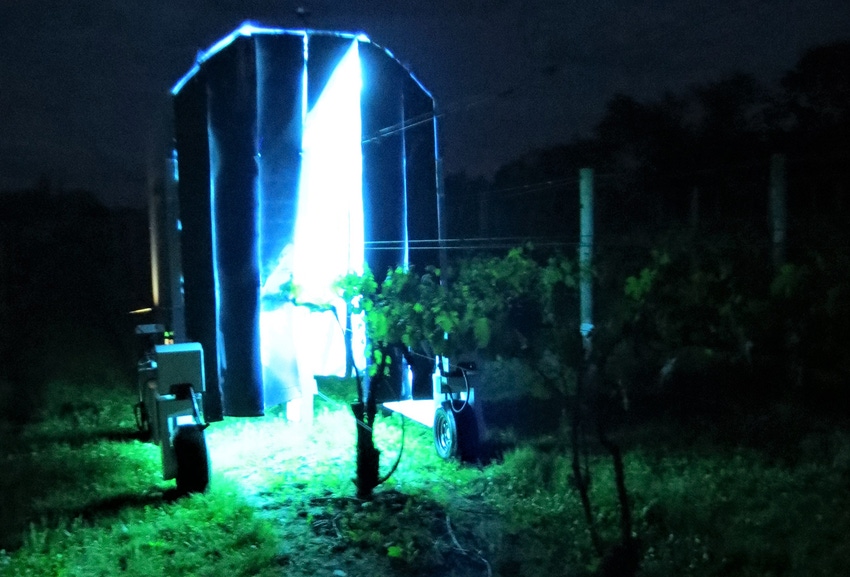
You knew we were headed in this direction and now — voila! — they’re here. Robots equipped with UV light have taken up the fight against powdery and downy mildew.
The welcome warriors do grape vine battle at night on two Chardonnay sites in New York and robot tender David Gadoury says, “We’ve got effective powdery mildew suppression for Chardonnay grapes over a two-year period with treatments once a week.”
And unlike contract hand labor, “These machines work every night of the week, all night long, applying the same dose of UV light to every vine,” he says. While workers tend vines during daylight hours, this is the night shift, tireless automatons fitted with ultraviolet light lamps roaming in a search-and-destroy mission against powdery mildew.
“We learned UV applications are much more effective at night,” said Gadoury, a Cornell University plant pathologist. Researchers there have partnered with SAGA Robotics in Norway to develop these 7-foot-tall pathogen slayers.
Speaking to his university publication, The Cornell Chronicle, he explained that while powdery mildews have co-evolved with the plants they attack and have developed resistance to chemical treatments, they do have an Achilles heel — adaptation to natural cycles of light and dark.”
UV light damages DNA and a nighttime application makes it possible to use UV to control plant pathogens. While many organisms have developed biochemical defenses against UV blue light triggered by sunlight, at night the pathogens don’t receive blue light and their repair mechanisms don’t work, so low doses of UV light can kill the pathogens without harming the plant.
Involved with grapevine pathology since the mid-1980s, Gadoury is excited about the success of the UV robots, although he declines to call them a “miracle cure” for grape growers.
"We get high activity against powdery mildew and some activity against downy mildew, but there are some diseases that probably won’t be controlled successfully by ultraviolet light,” he said. “But if you can take powdery mildew out of the picture, all the rest of your management options become much better — especially for Western growers in California, Washington, and Oregon.”
Also tackled downy mildew
The latest grape trials at Cornell not only brought powdery mildew under control, it tackled downy mildew also and collaborations with other universities have also led to trials with cucumbers, squash, pumpkins, basil, hops, and industrial hemp.
The UV-light nighttime technique is a breakthrough against the mildews that can adapt to chemical antifungal sprays, part of their evolution as they develop resistance to those chemical treatments in natural cycles of light and dark.
Fellow plant pathologist researcher Lance Cadle-Davidson told the Cornell newspaper, “We’re right now on Version 1.0 of this UV robot treatment, which applies the same dose of light to every vine, sick or healthy. Our long-term vision is we’ll couple these detection and treatment approaches across the vineyard in an automated way.”
The first commercial robotic units, autonomous vehicle robots fitted with 4-by-8-foot arrays, are slated to appear on the market later this year.
East Coast growers are at the center of origin for powdery and downy mildew. “We kind of own all the grapevine plagues with few exceptions,” Gadoury said. “This is our gift to the industry based on five years of research with a number of other universities and scientists. We are mission-oriented and projects like this are bearing fruit to help the men and women in the field growing grapes.”
Other areas of continuing research include a high-throughput robotic system (The Blackbird System) that allows detection and quantification assessment of powdery mildew breeding lines at over a thousand times the speed of past efforts.
For more news on pests, disease management and other issues affecting vineyards, subscribe to the bi-monthly newsletter The Grape Line.
About the Author(s)
You May Also Like




